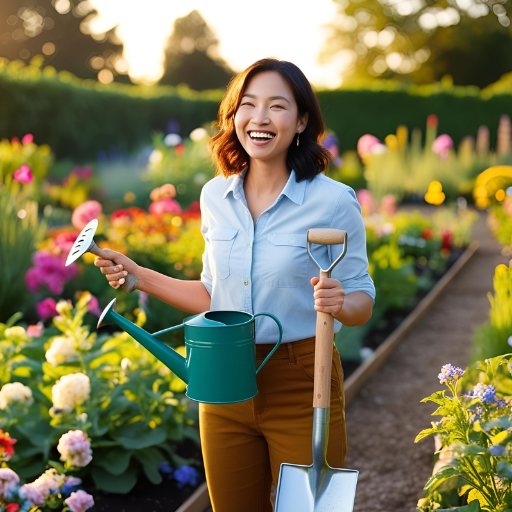Starting your gardening journey is exciting, but it can be a bit overwhelming when you’re faced with an aisle full of tools. The good news? You don’t need to buy everything at once. There are just a few essential gardening tools that can help make your planting, maintaining, and harvesting tasks easier and more enjoyable—especially if you’re a beginner.
In this guide, we’ll go through the must-have tools for any new gardener and offer tips on how to use and care for them properly.
Why Choosing the Right Tools Matters
Having the right tools isn’t just about convenience—it affects your success in the garden. Proper tools help you:
-
Work more efficiently
-
Reduce strain and injury
-
Get better planting and pruning results
-
Extend the life of your garden beds and containers
-
Enjoy the process more
Let’s dig into the essential tools you need to get started!
1. Hand Trowel
The hand trowel is one of the most versatile tools in any gardener’s kit.
Uses:
-
Digging small holes for planting
-
Transplanting seedlings
-
Removing weeds
-
Mixing soil and compost
Tips:
Look for a trowel with a sturdy stainless steel blade and a comfortable, non-slip handle. The blade should be slightly curved to hold soil well.
2. Pruning Shears (Secateurs)
Pruning shears are a must-have for trimming and shaping plants.
Uses:
-
Cutting back overgrown stems
-
Harvesting herbs or vegetables
-
Removing dead or damaged foliage
Tips:
Choose bypass pruners (with two curved blades) for clean cuts. Keep them sharp to avoid crushing stems, and clean them after use to prevent disease spread.
3. Garden Gloves
Protecting your hands while gardening is important for both safety and comfort.
Uses:
-
Preventing blisters and cuts
-
Protecting against thorns and splinters
-
Keeping your hands clean from dirt and compost
Tips:
Pick gloves that are breathable, waterproof, and snug-fitting. For heavy-duty work like rose pruning, use reinforced gloves with added protection.
4. Watering Can or Hose with Spray Nozzle
Water is life for plants, and you’ll need a good way to deliver it.
Uses:
-
Watering plants evenly and gently
-
Reaching tight or high-up spots
Tips:
A watering can is ideal for containers and indoor plants, while a hose with a spray nozzle is perfect for larger gardens. Look for adjustable nozzles that can switch from a fine mist to a steady stream.
5. Garden Fork
A garden fork is used to loosen, lift, and turn over soil.
Uses:
-
Breaking up compacted soil
-
Mixing compost into garden beds
-
Removing root vegetables like carrots and potatoes
Tips:
Choose a fork with strong, thick tines (prongs) made of stainless steel to prevent bending.
6. Hoe
The hoe is great for soil preparation and weeding.
Uses:
-
Removing weeds at the root
-
Creating shallow trenches for planting seeds
-
Breaking up surface soil crusts
Tips:
There are different types of hoes. A stirrup or loop hoe is excellent for weeding in tight spaces, while a draw hoe is better for digging.
7. Rake
Rakes aren’t just for leaves—they’re useful in soil management too.
Uses:
-
Smoothing soil
-
Gathering leaves, mulch, and debris
-
Spreading compost or soil evenly
Tips:
Use a bow rake for heavier tasks and a leaf rake for light cleanup.
8. Garden Kneeler or Pad
Gardening often involves kneeling, which can be tough on your knees.
Uses:
-
Providing comfort during weeding and planting
-
Preventing knee strain or pain
Tips:
A foam kneeling pad is lightweight and portable. You can also get a kneeler with side handles for extra support.
9. Wheelbarrow or Garden Cart
If you have a yard, a wheelbarrow is invaluable for moving heavy materials.
Uses:
-
Transporting soil, compost, tools, and plants
-
Making garden work faster and less physically demanding
Tips:
Choose a wheelbarrow with sturdy tires and a rust-proof tray. If you have limited space, opt for a foldable cart.
10. Soil Tester Kit
Healthy soil is the key to healthy plants. A soil tester helps you know what you’re working with.
Uses:
-
Measuring pH levels
-
Checking moisture and light levels
-
Testing nutrient content
Tips:
You can get simple kits or digital meters. Knowing your soil’s needs will help you adjust fertilization and plant selection accordingly.
Bonus: Tool Maintenance Tips
Your tools will last longer and work better with proper care. Here’s how to keep them in top shape:
-
Clean after each use: Remove soil and sap with a damp cloth or brush.
-
Dry tools thoroughly: Prevent rust by wiping tools dry before storage.
-
Sharpen blades regularly: Sharp blades make cleaner cuts and reduce plant damage.
-
Oil metal parts: Use vegetable oil or tool oil to prevent corrosion.
-
Store tools properly: Hang tools or keep them in a dry toolbox or shed.
Making Gardening Easier and More Enjoyable
Gardening should be a relaxing and joyful experience. With the right set of essential tools, even a beginner can confidently take on planting, pruning, watering, and caring for a wide variety of plants. Start with the basics, and as your skills grow, you can expand your toolkit based on your garden’s needs.
Remember: it’s not about having every fancy gadget—it’s about using the right tool for the right job.
